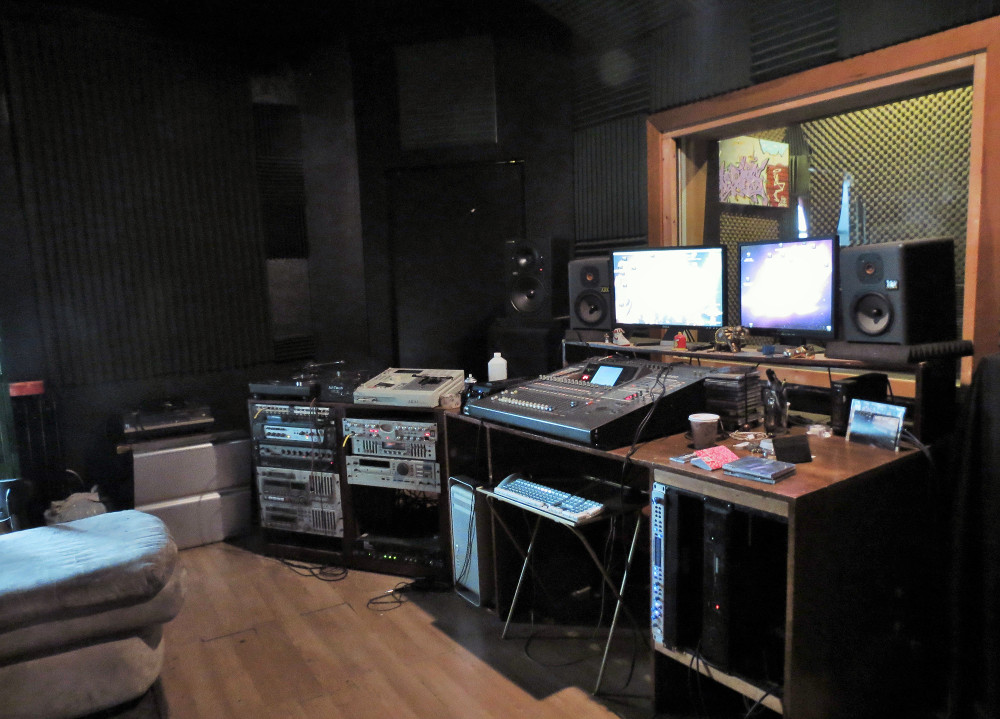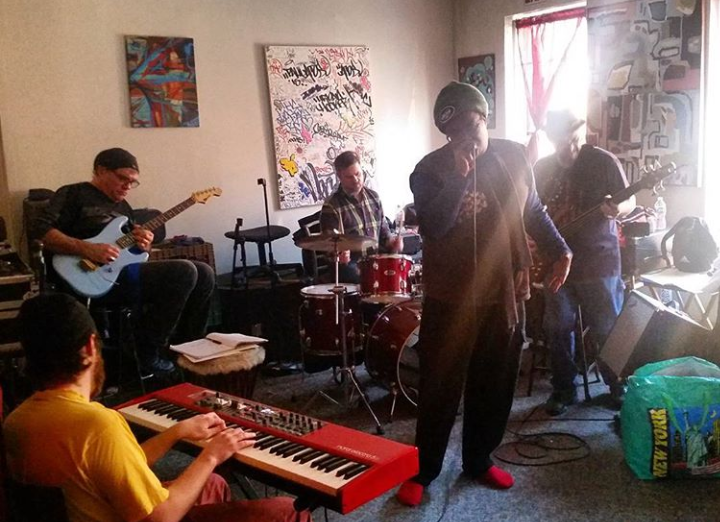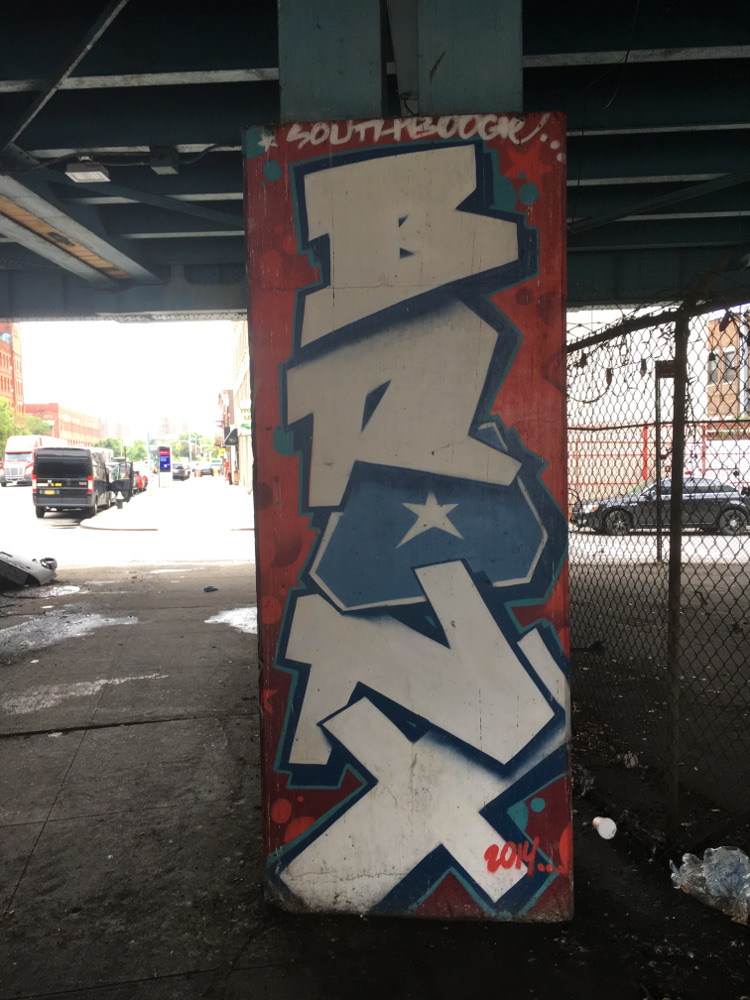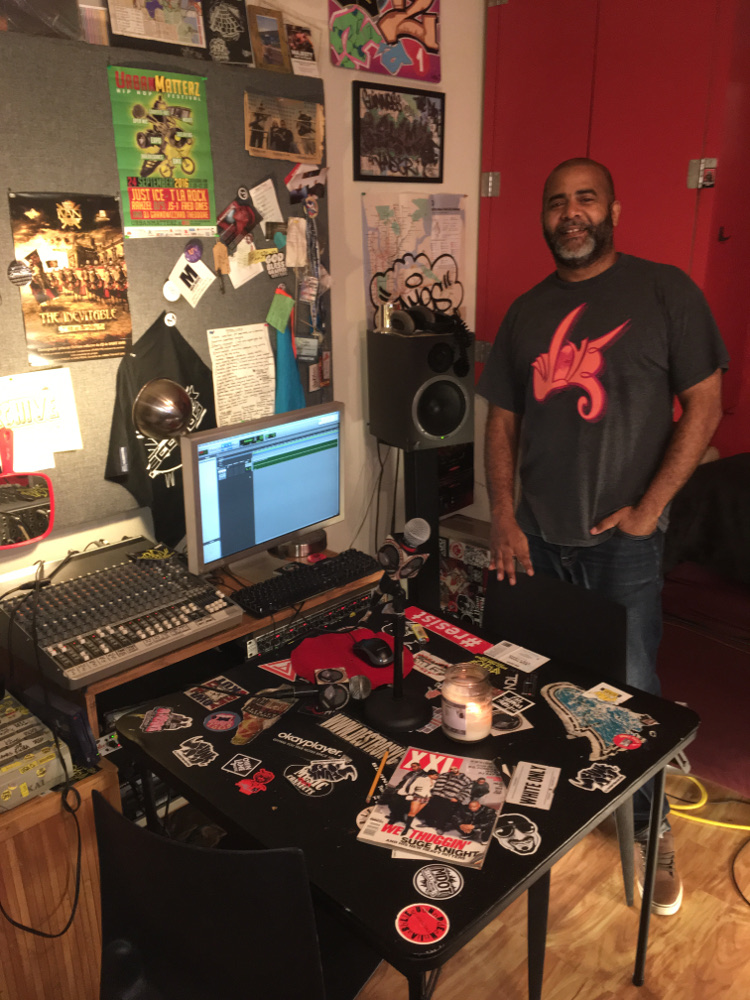Sounds of the South Bronx: Hip Hop and Community Converge at TME Pro Studios
You can find TME Pro easily — just keep your eyes out for the signs.
Strolling around the Port Morris neighborhood of the South Bronx, watch out for the telltale graffiti under a bridge. A series of wise and fierce futuristic creatures are stacked one atop the other on one column, another totem pole of angular heads from the neighborhood faces out from another column, while one more simply proudly proclaims “BRONX” in red white and blue.
Head a couple of blocks further uptown, and you’ll find the door with a red circle painted on it: this marker means you’re much closer. In fact, you’ve arrived at TME Pro. One part prolific hip hop studio, one part podcasting center, one part community hub, it’s a 100% welcoming experience for artists of all stripes.
The equal emphasis on music, visual art, and people above all flows from the varied experiences of founder Fred Ones, who saw his own career crossfade smoothly from graffiti artist to audio engineer and studio founder. “TME stands for The Midnight Eye, which originally was a graffiti crew,” Ones explains. “Our graffiti style was kind of Gothic, kind of dark. Those guys were into industrial music and hip hop, but you’d get a lot of fangs in the characters — it was a real gritty, hardcore style. That was the time and that was also the music: Hip hop was gritty in early nineties.”
While Ones’ tagging days are mostly behind him, he can clearly relate the unique satisfaction of being a graffiti artist. “A lot of it is about putting your name up and seeing it in a public space,” he says. “I think that’s the huge attraction to graffiti. You got to express yourself, then not only did you get to see it, the whole city got to see it. And scale: You’re expressing yourself on a large scale that’s public to everybody. That’s a rush. Then if you put the skill and talent into it and you start getting recognized for it, that’s a rush too, because there’s no money in it: People don’t get paid [to make graffiti]. They were stealing paint, risking their lives and their safety to do something for them and other graffiti writers. That’s a real love.
“I would say one of the most dominating art forms in the last thirty years is graffiti, because everyone got to see it. You didn’t have to go to the gallery to find out what graffiti was. It was in your face. Putting up letters and styles — that’s a huge, huge art form that influenced everywhere and everybody.”
Engineering Aha Moment
Ones was already an active DJ as he began delving into graffiti. For him, the common thread between his tagging and spinning activities is easy to identify. “Hip hop is the gel, that whole glue for everything,” he says. “Hip hop brought the DJing and the graffiti together.”
Although he was originally enrolled at the Art Institute of Chicago, Ones made a change to another Windy City educational institution. He dropped out of the Art Institute after two years, switching over to Chicago’s Columbia College to join its audio program. At first Ones was solely focused on becoming a beatmaker, but then saw there was a better career in learning audio engineering.
“I learned that engineering is a specific field for a limited amount of people,” he recalls. “You’ve got a ton of MCs, less DJs than MCs, less producers than DJs, and definitely less engineers than anybody else. I saw that quickly and I said, ‘This is a specialized field and it’s going to keep me in music,’ whether I’m working on my own stuff, or people are paying me to work on theirs. What I didn’t see ahead is what’s happened now: Working with people who I was a fan of, working with my idols, having them pay me to do what I do when I’m working with them. I never saw that coming.”
Cool for Kool Keith
TME Pro enjoys a steady flow of sessions, servicing indie and signed artists across multiple genres, with a heavy dose of hip-hop. The heart of the facility is the control room, high on creative vibes and low on light, a room that Ones intentionally keeps relatively dark to emphasize concentration.
It’s the yin to the sun-filled live room’s yang, which has plenty of cubic feet for a full band and houses a terrific-sounding drumkit. Depending on when your session is scheduled, any assortment of vibrant local art may be on the walls — but more on that in a minute.
Among those aforementioned musical icons who have been keeping TME Pro occupied is Kool Keith, who’s zeroed in on the studio to keep on adding to his prodigious output. “He takes his recording seriously,” Ones confirms. “He shows up on time. He doesn’t drink or smoke during sessions. He’s really about it and writes like no one I’ve ever seen before. He has songs all the time, and he’s always going to say something in that song that’s never been said before.”
Other high-profile clients at TME Pro include KRS-One, Prince Po, AG of DITC, Grand Daddy I.U., and Psycho Les. It’s a list that makes Ones pinch himself sometimes, especially when he recalls his roots as a beatmaker who was hugely influenced by DJ Premier. “He was my first major influence,” Ones recalls. “Then when I was going to school for engineering, Wu Tang came out and Rza became all of a sudden a huge, huge influence on me, as well as [Public Enemy’s] The Bomb Squad, right? That dense production, I was really into that, but that seemed like, ‘Man, those guys are geniuses,’ while Premier did more simple productions that I could see myself doing.
“When Rza came out,” continues Ones, “I feel like that there was a mix between that raw simple sound and simple loops, with these extra edit sounds that came sporadically out of nowhere. That reminded me of The Bomb Squad – Rza was putting in sounds that only played once or twice in the song and I said, ‘That’s old Bomb Squad techniques,’ doing stuff that’s unorthodox. The unorthodoxness of Rza drove me right in his corner and I became a huge, huge fan.”

Deep thought — the TME Pro control room stimulates both vibes and focus. Photo credit: Sublime Crown Productions, @sublimecrown // #sublimecrown
For Ones, however, much of the everyday artistry at TME Pro revolves around the key function of capturing hip hop vocal tracks. “Whether it’s hip hop or recording in general, when you have someone in the booth, you want to make sure their performance isn’t stifled in any way,” he says. “They should be able to do what they want to do in the booth. I want the person to feel free — that’s my approach to how they are in there. Are they comfortable? Can you hear yourself on your headphones? I’m really quick, but I think I’m quick in recording because I’m also very simple in what I do.”
What’s slightly more complex, however, is the psychology Ones and his engineers at TME Pro employ during recording. “You have to stay in control of the session,” he points out. “You have to let the artists know that you’re right with them, that they can ask for what they need and you can give it to them, but you’re actually driving the session. You’re giving the session constant communication as much as possible.”
While Ones is perfectly qualified to help give guidance, that’s a service he usually shies away from providing. “I’m not an artist’s developer — I’m not going to really get into your performance as long as you’re doing what I need you to do to come across the mic,” says Ones. “I think people get confused about what an engineer’s role is, but my job isn’t to produce you. I always feel like, ‘The artist’s had the song in his head way longer than we have as an engineer.’ We’ve just walked in on this thing, but they’ve had it in their head forever.”
Pivot to Podcasting
Also onsite is a dedicated podcast studio, a room that’s experiencing increased traffic as it hosts shows focused first and foremost on music discovery. Ones originally equipped the space with spare parts when he launched it in 2015, but quickly changed his tune and executed a more thorough buildout to host shows like the popular Guerrilla Grooves Radio, which is open for live audiences to sit in on.
“I didn’t realize how popular podcasts were going to be and what it would do for us in terms of promotion,” he says. “People would hear that our podcast is open doors, so they’d come by to check it out, and [then they say], ‘Oh, look at this room here. There’s another studio.’ So it’s a promotional tool, and it’s given us more notoriety in that way.”

Sound and vision inside the live room. Photo credit: Sublime Crown Productions, @sublimecrown // #sublimecrown
Today TME Pro is a veritable podcast factory, producing shows six days a week. Guerrilla Grooves Radio transmits from 7-10 every Tuesday, hosted by Ones, Rhinocerous Funk and L.I.F.E Long. If its hip hop music discovery you seek, you won’t get much closer to the street than this. “It’s an independent hip hop podcast where we have guests and we play about thirty songs, brand new that week, every week,” Ones notes.
Other regular podcasts produced at TME Pro include Disco Originalz dance-centric God Save the Groove, and The Three Amigos “which is a bunch of guys from Washington Heights just being crazy” playing reggaeton, hip hop, trap and bachata, and DJ R-Trane’s multi-genre Time Travel Mixshow.
At the Center of it All
While the vast majority of recording studios prefer to keep their location on the discreet side, TME Pro has a more outward-facing philosophy. Beyond tracking and mixing, the podcasts are just one activity that invites people to come inside and participate. On scheduled nights, the live room may host an art show opening, poetry reading, or regular events like The Lab hosted by Pushing Buttons Collective.
“That’s a producer event where they set up in the main gallery room and do a round robin playing beats,” says Ones. “That just brings the crowd in. Everybody wants to come and see the producers, and talk while they get inspired. They may go home and write something — a poem, a novel, do a painting. It helps in that way. It just continues to inspire and motivate people to be creative.”
The studio’s evolving role as a local resource wasn’t the original plan, but it’s been a process that Ones has been fascinated to watch unfold. “TME Pro is developing into a hub,” he observes. “It’s become a center point for people to come together, meet, talk, create ideas. It’s not just a studio, it’s become an entity. It’s become a very public, social place and I really do appreciate that. That’s my activism in a weird way: The proudest thing for me is a place for people to come together and be artistic.”
— David Weiss
Please note: When you buy products through links on this page, we may earn an affiliate commission.








